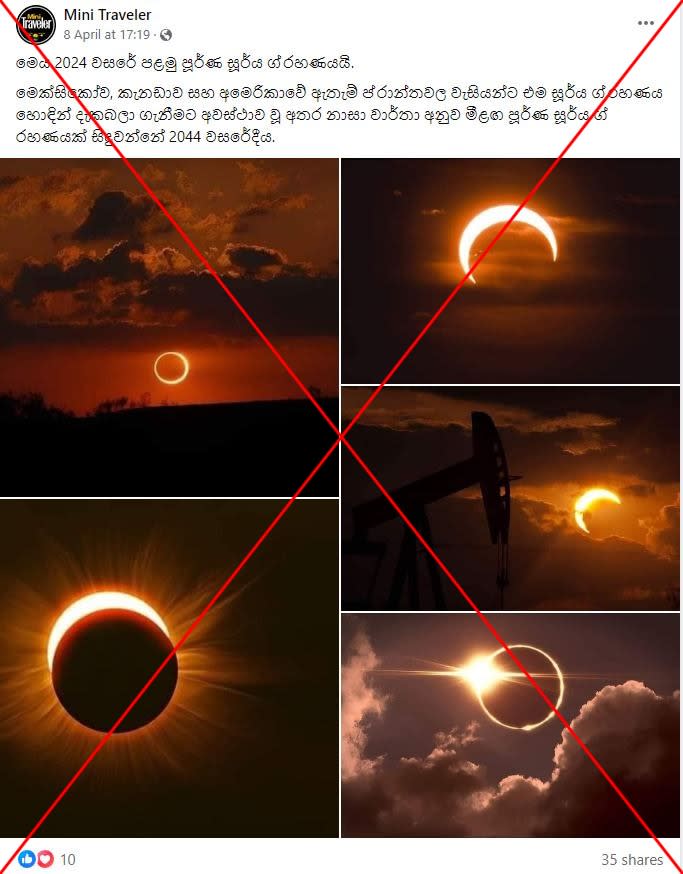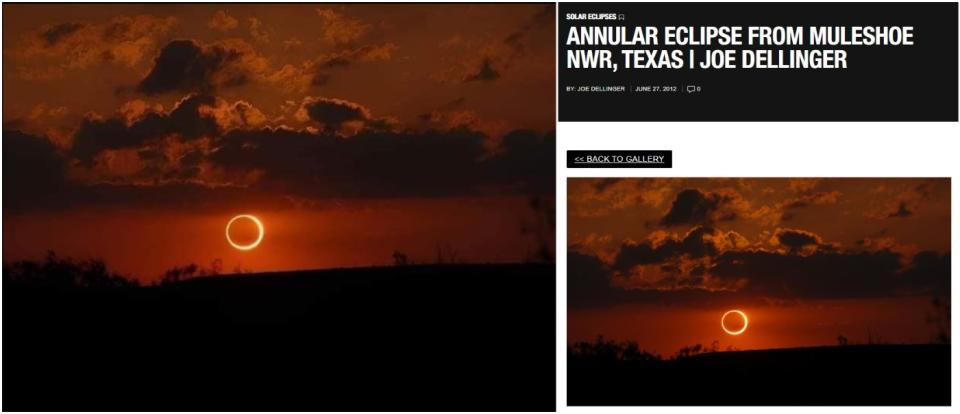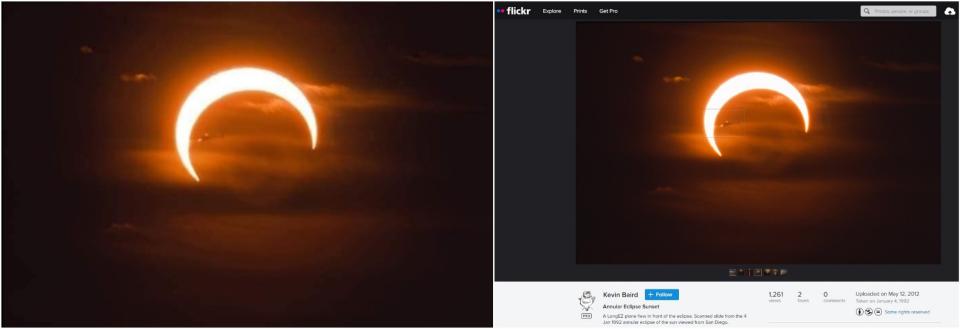Old photos falsely shared as April 2024 total solar eclipse
Old photos of past solar eclipses surfaced in social media posts that falsely claimed they showed the April 8, 2024 celestial event visible across a swathe of North America. The photos in fact show various eclipses from 1992, 2012 and 2017 in the United States. Another picture was posted on a stock image site in 2023.
"This is the first solar eclipse of 2024," reads a Sinhala-language Facebook post from April 8, 2024.
"The solar eclipse was clearly visible to residents of Mexico, Canada and some states in America and according to NASA reports, the next total solar eclipse will be in 2044."
It includes five images of eclipses.

The post surfaced after the Moon's shadow plunged the Pacific coast of Mexico into total darkness at 11:07 am local time (1807 GMT) on April 8, 2024.
The rare total solar eclipse then swept across the United States at supersonic speed, returning to the ocean over Canada's Atlantic coast just under an hour-and-a-half after landfall.
The spectacle left tens of millions awestruck, with viewing parties, festivals and even mass weddings taking place along the "path of totality", where the Sun's corona glowed from behind the Moon.
The same images was shared in Facebook groups with tens of thousands of members, including here and here, in posts that claimed they showed the celestial spectacle.
But the photos predate the April 8 eclipse.
Past solar eclipse photos
Two of the photos were taken in the southern US state of Texas during a 2012 annular eclipse -- when the Moon blocks the Sun while it is at or near its farthest point from Earth, only partially covering the Sun (archived link).
A Google reverse image search found the first photo published on astronomy website Sky & Telescope on June 27, 2012 (archived link).
The picture was credited to photographer Joe Dellinger and the date and location of the photo given as May 21, 2012 at the Muleshoe National Wildlife Reserve.
A "ring of fire" solar eclipse was visible across the Pacific from Japan, Hong Kong and Taiwan in Asia to California and Texas in the United States on May 20 and 21, 2012.
Below is a screenshot comparison of the photo used in the false posts (left) and the photo published by Sky & Telescope (right):

The second photo of the 2012 eclipse, which shows an oil rig silhouetted against the celestial event, was taken by The Associated Press news agency.
According to stock photo site Alamy, which shared the photo, it was taken by Albert Cesare on May 20, 2012 north of Odessa, Texas (archived link).
Below is a screenshot comparison of the photo used in the false posts (left) and The AP photo (right):

Cesare posted a similar photo of the eclipse with an oil rig in the foreground on his Instagram page in 2017, saying it was taken on May 20, 2012 (archived link).
Another photo shared in Facebook posts, which shows the Sun partially eclipsed by the Moon as a plane flies by, was taken during another annular eclipse in 1992.
AFP found the photo uploaded to photo-sharing site Flickr on May 12, 2012 by a user named Kevin Baird (archived link).
"A LongEZ plane flew in front of the eclipse. Scanned slide from the 4 Jan 1992 annular eclipse of the sun viewed from San Diego," the caption read.
Clouds had obscured the view of the January 4 and 5, 1992 "ring of fire" for most places, but San Diego received a "spectacular" view of the sight, the Washington Post reported at the time (archived link).
Below is a screenshot comparison of the photo in the false post (left) and the photo uploaded to Flickr (right):

Reverse image searches found the fourth photo published by visual media company Getty Images in 2017 (archived link).
The photo, titled "Solar eclipse August 21 Wisconsin", is credited to "Matt Anderson Photography".
The US state of Wisconsin saw a maximum 85 percent solar eclipse on August 21, 2017, during a total solar eclipse that crossed the United States in the first time in almost a century, according to a news release by the University of Wisconsin-Madison (archived link).
Below is a screenshot comparison of the photo in the false posts (left) and the photo uploaded to Getty Images (right):

Keyword searches found the same photo uploaded to Anderson's website, with a caption saying it was shot in rural southwest Wisconsin (archived link).
Stock image
The last image was posted on Getty Images' stock photo provider iStock on April 11, 2023 -- one year before the 2024 solar eclipse (archived link).
The caption read: "Total eclipse of the Sun. The Moon covers the Sun in a solar eclipse -- Stock Photo."
Below is a screenshot comparison of the image in the false post (left) and the image on iStock (right):

The image is credited to a user called Pitris.
Further Google keyword searches found the user's profile on another stock photo website (archived link).
According to the bio, the user is a graphic designer, illustrator and photographer and frequently uploads images of astronomical phenomena.
AFP has debunked other false claims following the April 8, 2024 solar eclipse here, here and here.


